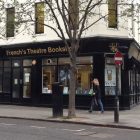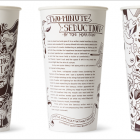Round-Down: Adam Johnson’s New Story to Sell for $9,000
Adam Johnson, the author of Pulitzer Prize-winning The Orphan Master’s Son, has a new story collection, Fortunes Smiles, out today. The collection, which includes six stories, was recently reviewed, with high praise, by Lauren Groff for The New York Times.
Each of the stories in the collection have appeared in esteemed journals such as Tin House, except one. In December, this story, “George Orwell Was a Friend of Mine,” will be the feature of a collaboration with the artists at 21st Editions called “The Janus Turn.” Only thirty-seven copies of the resulting work will be produced. And they will each sell for the handsome sum of nine thousand dollars.
Ron Charles at The Washington Post said of the collaboration: “What a different experience this will be than scrolling through the text on your e-reader. You would never accidentally leave this on the subway.”
It’s true, of course—you wouldn’t. 21st Editions is a maker of literature-focused art that encourages the exploration of the thoughtful intersection between content and its forms.
But does engaging with a story differently, in another format, ineluctably change the story itself? I’d argue the answer is yes—it does. That the work is titled “The Janus Turn” already creates a new perspective, a complicated duality, story and art mirroring one another.
If there is another question, then, it seems to be: Is “The Janus Turn” worth $9,000? To which I would respond, “Of course. Could a Picasso be worth millions?”
It’s true that it’s not the same thing—but I do think that it is impossibly difficult to assign monetary value to the care taken and the process endured in creating art.
It would be interesting to see how 21st Editions could grow its operation with other written work or make its art more accessible. It does seem, however, that these are things that seem to run in some discord with the company’s high aim to follow, as noted in the Wall Street Journal, “in Alfred Stieglitz’s footsteps,” in enriching and exalting photography as an art form. Compromise in any direction would simply cheapen the work. This is art at its highest and, sure, most expensive, but it is well worth our attention and admiration.




